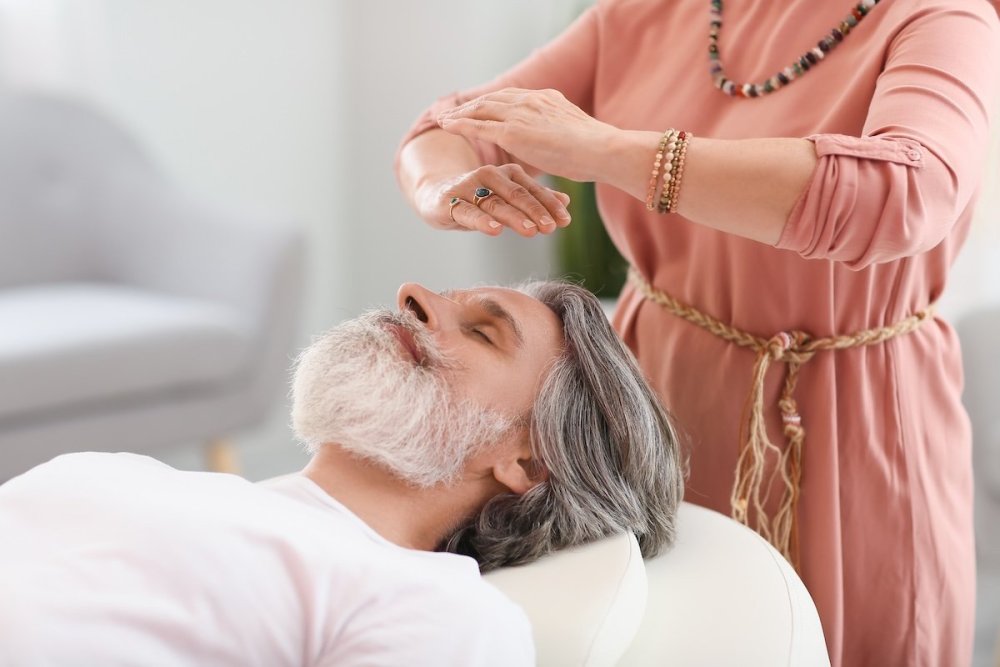With a multitude of Reiki types and styles available, choosing a healing treatment can be overwhelming. Rachel Markowitz outlines 14 types of Reiki – such as crystal, kundalini, and karuna – and explains the key to finding the practice that aligns best with you.
Reiki refers to the Japanese representation of universal life force energy (composed of rei, “spiritual/universal”: 靈, and kei, “life force/energy”: 氣). It's also the name of the hands-on healing practice that harnesses this energy. In a Reiki session, energy flows where needed, facilitating the body’s innate tendency to self-heal at physical, mental, emotional, and spiritual levels.
The ability to feel, channel, and heal with Reiki is directly transmitted through an unbroken lineage of Reiki Masters. However, since Reiki’s documented origins in the early 1900s in Japan, practices and teachings have been adapted, added to, and re-interpreted – resulting in dozens of types and hundreds of branches of Reiki.
To better understand the many styles of Reiki, we’ll learn the stories behind the most well-known lineages, explore their unique qualities, and discuss how to select a practice that’s best suited for you.
The Different Types of Reiki
According to William Lee Rand, founder of the International Center for Reiki Training (ICRT), there are four qualities that define Reiki:
- Reiki energy comes from initiation (called attunement).
- Reiki is passed down through a direct lineage with continuous teachings.
- Reiki energy is guided by a higher power (and doesn’t require direction from a healer).
- Reiki cannot harm.
With this in mind, the following types of Reiki display the wide range of healing techniques that have manifested throughout Reiki’s journey from Japan to the U.S. and beyond.
1. Usui Reiki
Traditional Reiki is commonly called “Usui Reiki,” after Mikao Usui Sensei, who developed the Reiki system that spread throughout the world. However, Usui Reiki practices are divided into two distinct types, Usui Reiki Ryoho and Usui Shiki Ryoho, which provide a foundation for the majority of today’s different types of Reiki.
-
Usui Reiki Ryoho is the name given by Usui Sensei to his original Reiki “discovery” in 1922. Although Reiki healing already existed at that time, Usui experienced a spontaneous, enlightening transmission of Reiki energy, along with the ability to heal through his hands. Usui then developed a set of practices and moral principles, providing an ethically-based spiritual practice, predominantly for self-healing. His teachings include symbols, mantras, hands-on healing techniques, and meditative practices.
When these traditional Reiki teachings were adjusted for Westerners (primarily by Mrs. Hawayo Takata and her teacher Chujiro Hayashi in the late 1930s), these “traditional” teachings became known as Usui Shiki Ryoho.
- Usui Shiki Ryoho, also known as Western Reiki, diverges from Usui’s original Reiki by condensing Reiki attunements into three distinct levels. It also incorporated fixed hand positions for healing and required Reiki to be passed on as an oral tradition. These days, almost all “traditional” or “Usui” Reiki practitioners come from the lineage of Mrs. Takata and the 22 Reiki Masters that she initiated.

Healing hands: there are many styles of Reiki
2. Jikiden Reiki
Jikiden Reiki is considered “Japanese” or “Eastern” Reiki. Like Western Reiki, it originates from Usui’s direct lineage. However, since Usui’s practice changed throughout its time in the West, Jikiden was founded in Japan in the late 1990s to preserve Usui’s teachings. It emphasizes body scanning and intuitive hand placement rather than pre-determined hand positions for healing treatments. Jikiden healers work with healing physical and mental ailments, and also spiritual development.
3. Gendai Reiki-ho
Gendai Reiki-ho is an adaptation of Usui Reiki created by Sensei Hiroshi Doi of Japan in 1993. Its name translates simply to “Modern Reiki Method.” Gendai Reiki Ho is a combination of traditional Reiki from Usui’s school, some of which fell out of use during Reiki’s evolution, with Western Reiki and other healing modalities. Gendai Reiki-ho is typically taught to students who have already learned Reiki at the Master level. It also emphasizes spiritual connection alongside physical healing.
4. Rainbow Reiki
Rainbow Reiki is a a type of Reiki developed by Walter Lübeck in the 1980s as an evolution of Usui Reiki. Lübeck’s healing practice integrates the seven chakras – centers of concentrated vital energy, according to yogic philosophy – into its methodology.
“Since Reiki’s documented origins in the early 1900s in Japan, practices and teachings have been adapted, added to, and re-interpreted – resulting in dozens of types of Reiki.”
Rainbow Reiki is commonly used for chakra healing, clearing, and balancing. It often incorporates crystals, aura cleansing, mantras, and karmic healing into sessions. Although this may seem complex, Rainbow Reiki is described as both powerful and direct.
5. Karuna Reiki®
Karuna Reiki® is a trademarked lineage of Reiki founded by William Rand in the mid-90s. Karuna is Sanskrit for compassion, and Karuna Reiki® emphasizes healing through kindness and empathy, often focusing on the emotional and spiritual well-being of clients. During treatments, healers use a unique set of symbols, along with the energies of archangels and ascended masters, and chanting practices. Karuna Reiki® works alongside traditional Reiki, and a healer needs to be attuned to Reiki at a Master level to learn its methods.
6. Holy Fire® Reiki
Holy Fire® Reiki was also developed by William Rand as an advanced practice for healers working beyond the scope of Karuna Reiki®. Holy Fire® was added to Rand’s lineage in 2014. It includes a new symbol, along with practices that allow a practitioner to deepen their healing powers. According to Rand, Holy Fire® Reiki energy leads to “purification, healing, empowerment, and guidance.”
7. Crystal Reiki
Crystal Reiki describes any Reiki practice that uses crystals, often infused with Reiki energy, to enhance the healing qualities of Reiki energy. During these sessions, healers place crystals with various energetic properties on or around the body to amplify or add specific frequencies and intentions to other Reiki techniques.

Crystal Reiki is a popular style
8. Tibetan Reiki
“Tibetan Reiki” typically refers to Tibetan Usui Reiki, a combination of traditional Reiki with aspects of healing used in Tibetan shamanism. This type of Reiki was developed by an American Usui Reiki Master, Arthur Robinson, in the early 1980s and popularized by William Rand. Tibetan Reiki involves two symbols from Tibetan Buddhism, healing crystals, and spiritual guides.
“Different types of Reiki do not compete with each other; they complement each other. Since all Reiki practices aim to provide holistic health and well-being, there’s no harm in experimenting.”
However, there is also a less popular lineage of Tibetan Reiki that was passed down from Tschen Li, a Tibetan Monk, whose teachings predate (and were allegedly shared with) Mikao Usui.
9. Sekhem Reiki
Sekhem is the ancient Egyptian term for life force energy, and Seichim is the traditional Egyptian form of energy healing. Thus, combining Egyptian healing with Japanese Reiki results in what’s known as Seichim, Sekhem, or Sekhem-Seichim Reiki. Sekhem healing was popularized by Patrick Zeigler in 1980 after a mystical transmission of energy through a heart-opening experience in the Great Pyramid in Egypt. Sekhem Reiki practices focus on the heart center and a central channel of light throughout the body.
…And More
Other Reiki styles worth a shout-out (and some research for those inclined) include:
- Tera Mai™ Reiki: Combines the energy of Reiki, Seichem, Earth’s elements, and teachings channeled from the Buddha
- Lightarian Reiki: Emphasizes high vibrations and enlightenment
- Shamballa Reiki: Calls on Ascended Master St. Germain for multidimensional healing
- Violet Flame Reiki: Uses 40 symbols that were channeled from Quan Yin, the Buddhist goddess of compassion
- Kundalini Reiki: Focuses on Kundalini, vital energy that rises through the spinal column when we spiritually awaken.
Which Type of Reiki Is Right for Me?
With so many different types of Reiki, those new to healing may feel overwhelmed by options. When deciding between styles, factors to consider include:
-
Intention The reason for your interest in Reiki will point you towards the best practices for you. For instance, you might consider traditional (Usui) Reiki or Jikiden Reiki if your purpose is simply to experience Reiki energy, relax, or intentionally heal an ailment. However, if your intention is spiritual evolution, Sekhem Reiki or Rainbow Reiki could be best for you.
-
Spiritual or Healing-Related Interests As we’ve learned, Reiki can be integrated with religious, cultural, and shamanic traditions, and amplified by crystals or other objects. Thus, if you’re specifically inclined towards any of the less-traditional Reiki styles outlined above, this would be a good place to start.
For example, if you’re fascinated by crystals or gemstones, try Crystal Reiki. If you’re curios about Ancient Egyptian civilizations or Buddhism, Reiki that integrates aspects of these traditions would be a natural introduction to the realm of hands-on healing.
Reiki types do not compete; they complement each other
-
Connection to Specific Teachers or Healers Selecting the right Reiki practitioner is just as important (arguably more so) than selecting a style of Reiki. In fact, many Reiki healers are Masters in several different types of Reiki. So, if you find a Reiki Master/Teacher who feels friendly or familiar, or a specific healer comes to you through recommendation, it may be helpful to follow the universe’s nudges.
- Intuition (Curiosity) Finally, if you have an intuitive feeling or spiritual pull towards the name of a Reiki lineage, place of healing, or Reiki Master, heed the call!
Remember – different types of Reiki do not compete with each other; they complement each other. Since all Reiki practices aim to provide holistic health and well-being, there’s no harm in experimenting with different types of Reiki as you see fit. Reiki energy is Reiki energy, regardless of lineage.
Takeaway: The Many Styles of Reiki
Understanding the different types of Reiki out there requires a journey through the history of established Reiki Masters, as modern-day Reiki healers are often associated with lineages that integrate traditional Reiki energy with other ancient or new-age practices. When deciding on a particular type of Reiki healing, a combination of your intentions, interests, and intuitive inclinations will guide you along the unique path that’s right for you. ●
Images Pixel-Shot, New Africa, Pixel Shot
happiness.com | The fine art of being: learn, practise, share
Are you a happiness.com member? Sign up for free to enjoy:
■ our happiness magazine with practical life tips
■ sharing and supporting others in our happiness forum
Written by Rachel Markowitz
 Rachel recently found herself over a decade deep in a worldwide wander guided by what she feels to be true. She’s been facilitating classes and workshops on yoga, meditation, self-exploration, and alternative ways of living since 2012, mostly in Latin America and Asia. These days, she spends most of her time looking at, walking around, or singing to a sacred mountain in southern India. Read more of her words at her to those who wonder blog.
Rachel recently found herself over a decade deep in a worldwide wander guided by what she feels to be true. She’s been facilitating classes and workshops on yoga, meditation, self-exploration, and alternative ways of living since 2012, mostly in Latin America and Asia. These days, she spends most of her time looking at, walking around, or singing to a sacred mountain in southern India. Read more of her words at her to those who wonder blog.





Join the conversation
You are posting as a guest. If you have an account, sign in now to post with your account.
There are no comments to display.